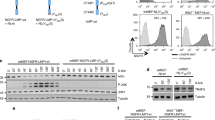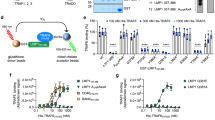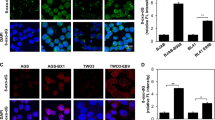Abstract
In this study, we determined the respective roles of RelA and RelB NF-κB subunits in Epstein–Barr virus (EBV)-transformed B cells. Using different EBV-immortalized B-cell models, we showed that only RelA activation increased both survival and cell growth. RelB activity was induced secondarily to RelA activation and repressed RelA DNA binding by trapping the p50 subunit. Reciprocally, RelA activation repressed RelB activity by increasing expression of its inhibitor p100. To search for such reciprocal inhibition at the transcriptional level, we studied gene expression profiles of our RelA and RelB regulatable cellular models. Ten RelA-induced genes and one RelB-regulated gene, ARNTL2, were repressed by RelB and RelA, respectively. Apart from this gene, RelB signature was included in that of RelA Functional groups of RelA-regulated genes were for control of energy metabolism, genetic instability, protection against apoptosis, cell cycle and immune response. Additional functions coregulated by RelA and/or RelB were autophagy and plasma cell differentiation. Altogether, these results demonstrate a cross-inhibition between RelA and RelB and suggest that, in fine, RelB was subordinated to RelA. In the view of future drug development, RelA appeared to be pivotal in both classical and alternative activation pathways, at least in EBV-transformed B cells.
This is a preview of subscription content, access via your institution
Access options
Subscribe to this journal
Receive 12 print issues and online access
$259.00 per year
only $21.58 per issue
Buy this article
- Purchase on Springer Link
- Instant access to full article PDF
Prices may be subject to local taxes which are calculated during checkout





Similar content being viewed by others
References
Young LS, Rickinson AB . Epstein-Barr virus: 40 years on. Nat Rev Cancer 2004; 4: 757–768.
Mosialos G, Birkenbach M, Yalamanchili R, VanArsdale T, Ware C, Kieff E . The Epstein-Barr virus transforming protein LMP1 engages signaling proteins for the tumor necrosis factor receptor family. Cell 1995; 80: 389–399.
Faumont N, Chanut A, Benard A, Cogne N, Delsol G, Feuillard J et al. Comparative analysis of oncogenic properties and nuclear factor-kappaB activity of latent membrane protein 1 natural variants from Hodgkin’s lymphoma’s Reed-Sternberg cells and normal B-lymphocytes. Haematologica 2009; 94: 355–363.
Vallabhapurapu S, Karin M . Regulation and function of NF-kappaB transcription factors in the immune system. Annu Rev Immunol 2009; 27: 693–733.
Israël A . The IKK complex, a central regulator of NF-kappaB activation. Cold Spring Harb Perspect Biol 2010; 2: a000158.
Scheidereit C . IkappaB kinase complexes: gateways to NF-kappaB activation and transcription. Oncogene 2006; 25: 6685–6705.
Dejardin E . The alternative NF-kappaB pathway from biochemistry to biology: pitfalls and promises for future drug development. Biochem Pharmacol 2006; 72: 1161–1179.
Luftig M, Yasui T, Soni V, Kang M-S, Jacobson N, Cahir-McFarland E et al. Epstein-Barr virus latent infection membrane protein 1 TRAF-binding site induces NIK/IKK alpha-dependent noncanonical NF-kappaB activation. Proc Natl Acad Sci USA 2004; 101: 141–146.
Atkinson PGP, Coope HJ, Rowe M, Ley SC . Latent membrane protein 1 of Epstein-Barr virus stimulates processing of NF-kappa B2 p100 to p52. J Biol Chem 2003; 278: 51134–51142.
Eliopoulos AG, Caamano JH, Flavell J, Reynolds GM, Murray PG, Poyet J-L et al. Epstein-Barr virus-encoded latent infection membrane protein 1 regulates the processing of p100 NF-kappaB2 to p52 via an IKKgamma/NEMO-independent signalling pathway. Oncogene 2003; 22: 7557–7569.
Saito N, Courtois G, Chiba A, Yamamoto N, Nitta T, Hironaka N et al. Two carboxyl-terminal activation regions of Epstein-Barr virus latent membrane protein 1 activate NF-kappaB through distinct signaling pathways in fibroblast cell lines. J Biol Chem 2003; 278: 46565–46575.
Le Clorennec C, Youlyouz-Marfak I, Adriaenssens E, Coll J, Bornkamm GW, Feuillard J . EBV latency III immortalization program sensitizes B cells to induction of CD95-mediated apoptosis via LMP1: role of NF-kappaB, STAT1, and p53. Blood 2006; 107: 2070–2078.
Ferreira V, Sidénius N, Tarantino N, Hubert P, Chatenoud L, Blasi F et al. In vivo inhibition of NF-kappa B in T-lineage cells leads to a dramatic decrease in cell proliferation and cytokine production and to increased cell apoptosis in response to mitogenic stimuli, but not to abnormal thymopoiesis. J Immunol 1999; 162: 6442–6450.
Bornkamm GW, Berens C, Kuklik-Roos C, Bechet J-M, Laux G, Bachl J et al. Stringent doxycycline-dependent control of gene activities using an episomal one-vector system. Nucleic Acids Res 2005; 33: e137.
Le Clorennec C, Ouk T-S, Youlyouz-Marfak I, Panteix S, Martin C-C, Rastelli J et al. Molecular basis of cytotoxicity of Epstein-Barr virus (EBV) latent membrane protein 1 (LMP1) in EBV latency III B cells: LMP1 induces type II ligand-independent autoactivation of CD95/Fas with caspase 8-mediated apoptosis. J Virol 2008; 82: 6721–6733.
Kempkes B, Spitkovsky D, Jansen-Dürr P, Ellwart JW, Kremmer E, Delecluse HJ et al. B-cell proliferation and induction of early G1-regulating proteins by Epstein-Barr virus mutants conditional for EBNA2. EMBO J 1995; 14: 88–96.
Caux C, Massacrier C, Vanbervliet B, Dubois B, Van Kooten C, Durand I et al. Activation of human dendritic cells through CD40 cross-linking. J Exp Med 1994; 180: 1263–1272.
Feuillard J, Schuhmacher M, Kohanna S, Asso-Bonnet M, Ledeur F, Joubert-Caron R et al. Inducible loss of NF-kappaB activity is associated with apoptosis and Bcl-2 down-regulation in Epstein-Barr virus-transformed B lymphocytes. Blood 2000; 95: 2068–2075.
Faumont N, Le Clorennec C, Teira P, Goormachtigh G, Coll J, Canitrot Y et al. Regulation of DNA polymerase beta by the LMP1 oncoprotein of EBV through the nuclear factor-kappaB pathway. Cancer Res 2009; 69: 5177–5185.
Baran-Marszak F, Feuillard J, Najjar I, Le Clorennec C, Béchet J-M, Dusanter-Fourt I et al. Differential roles of STAT1alpha and STAT1beta in fludarabine-induced cell cycle arrest and apoptosis in human B cells. Blood 2004; 104: 2475–2483.
Smyth GK, Michaud J, Scott HS . Use of within-array replicate spots for assessing differential expression in microarray experiments. Bioinforma Oxf Engl 2005; 21: 2067–2075.
Reiner-Benaim A . FDR control by the BH procedure for two-sided correlated tests with implications to gene expression data analysis. Biom J Biom Z 2007; 49: 107–126.
Tusher VG, Tibshirani R, Chu G . Significance analysis of microarrays applied to the ionizing radiation response. Proc Natl Acad Sci USA 2001; 98: 5116–5121.
Graham JP, Arcipowski KM, Bishop GA . Differential B-lymphocyte regulation by CD40 and its viral mimic, latent membrane protein 1. Immunol Rev 2010; 237: 226–248.
Traenckner EB, Wilk S, Baeuerle PA . A proteasome inhibitor prevents activation of NF-kappa B and stabilizes a newly phosphorylated form of I kappa B-alpha that is still bound to NF-kappa B. EMBO J 1994; 13: 5433–5441.
Basso K, Margolin AA, Stolovitzky G, Klein U, Dalla-Favera R, Califano A . Reverse engineering of regulatory networks in human B cells. Nat Genet 2005; 37: 382–390.
Alizadeh AA, Eisen MB, Davis RE, Ma C, Lossos IS, Rosenwald A et al. Distinct types of diffuse large B-cell lymphoma identified by gene expression profiling. Nature 2000; 403: 503–511.
Camara DA, Stefanoff CG, Pires ARC, Soares F, Biasoli I, Zalcberg I et al. Immunoblastic morphology in diffuse large B-cell lymphoma is associated with a nongerminal center immunophenotypic profile. Leuk Lymphoma 2007; 48: 892–896.
Ranuncolo SM, Pittaluga S, Evbuomwan MO, Jaffe ES, Lewis BA . Hodgkin lymphoma requires stabilized NIK and constitutive RelB expression for survival. Blood 2012; 120: 3756–3763.
Demchenko YN, Kuehl WM . A critical role for the NFkB pathway in multiple myeloma. Oncotarget 2010; 1: 59–68.
Cormier F, Monjanel H, Fabre C, Billot K, Sapharikas E, Chereau F et al. Frequent engagement of RelB activation is critical for cell survival in multiple myeloma. PloS One 2013; 8: e59127.
Chao C, Silverberg MJ, Martínez-Maza O, Chi M, Abrams DI, Haque R et al. Epstein-Barr virus infection and expression of B-cell oncogenic markers in HIV-related diffuse large B-cell Lymphoma. Clin Cancer Res Off J Am Assoc Cancer Res 2012; 18: 4702–4712.
Compagno M, Lim WK, Grunn A, Nandula SV, Brahmachary M, Shen Q et al. Mutations of multiple genes cause deregulation of NF-kappaB in diffuse large B-cell lymphoma. Nature 2009; 459: 717–721.
Zhang B, Kracker S, Yasuda T, Casola S, Vanneman M, Hömig-Hölzel C et al. Immune surveillance and therapy of lymphomas driven by Epstein-Barr virus protein LMP1 in a mouse model. Cell 2012; 148: 739–751.
Shair KHY, Bendt KM, Edwards RH, Bedford EC, Nielsen JN, Raab-Traub N . EBV latent membrane protein 1 activates Akt, NFkappaB, and Stat3 in B cell lymphomas. PLoS Pathog 2007; 3: e166.
Derudder E, Dejardin E, Pritchard LL, Green DR, Korner M, Baud V . RelB/p50 dimers are differentially regulated by tumor necrosis factor-alpha and lymphotoxin-beta receptor activation: critical roles for p100. J Biol Chem 2003; 278: 23278–23284.
Lo JC, Basak S, James ES, Quiambo RS, Kinsella MC, Alegre M-L et al. Coordination between NF-kappaB family members p50 and p52 is essential for mediating LTbetaR signals in the development and organization of secondary lymphoid tissues. Blood 2006; 107: 1048–1055.
Shih VF-S, Tsui R, Caldwell A, Hoffmann A . A single NFκB system for both canonical and non-canonical signaling. Cell Res 2011; 21: 86–102.
Liptay S, Schmid RM, Nabel EG, Nabel GJ . Transcriptional regulation of NF-kappa B2: evidence for kappa B-mediated positive and negative autoregulation. Mol Cell Biol 1994; 14: 7695–7703.
Bren GD, Solan NJ, Miyoshi H, Pennington KN, Pobst LJ, Paya CV . Transcription of the RelB gene is regulated by NF-kappaB. Oncogene 2001; 20: 7722–7733.
Basak S, Shih VF-S, Hoffmann A . Generation and activation of multiple dimeric transcription factors within the NF-kappaB signaling system. Mol Cell Biol 2008; 28: 3139–3150.
Jacque E, Tchenio T, Piton G, Romeo P-H, Baud V . RelA repression of RelB activity induces selective gene activation downstream of TNF receptors. Proc Natl Acad Sci USA 2005; 102: 14635–14640.
Lovas A, Radke D, Albrecht D, Yilmaz ZB, Möller U, Habenicht AJR et al. Differential RelA- and RelB-dependent gene transcription in LTbetaR-stimulated mouse embryonic fibroblasts. BMC Genomics 2008; 9: 606.
Moretti M, Bennett J, Tornatore L, Thotakura AK, Franzoso G . Cancer: NF-κB regulates energy metabolism. Int J Biochem Cell Biol 2012; 44: 2238–2243.
Samudio I, Harmancey R, Fiegl M, Kantarjian H, Konopleva M, Korchin B et al. Pharmacologic inhibition of fatty acid oxidation sensitizes human leukemia cells to apoptosis induction. J Clin Invest 2010; 120: 142–156.
Pike LS, Smift AL, Croteau NJ, Ferrick DA, Wu M . Inhibition of fatty acid oxidation by etomoxir impairs NADPH production and increases reactive oxygen species resulting in ATP depletion and cell death in human glioblastoma cells. Biochim Biophys Acta 2011; 1807: 726–734.
Menendez JA, Lupu R . Fatty acid synthase and the lipogenic phenotype in cancer pathogenesis. Nat Rev Cancer 2007; 7: 763–777.
Care MA, Barrans S, Worrillow L, Jack A, Westhead DR, Tooze RM . A microarray platform-independent classification tool for cell of origin class allows comparative analysis of gene expression in diffuse large B-cell lymphoma. PLoS One 2013; 8: e55895.
Johansen LM, Deppmann CD, Erickson KD, Coffin WF 3rd, Thornton TM, Humphrey SE et al. EBNA2 and activated Notch induce expression of BATF. J Virol 2003; 77: 6029–6040.
Farrell CJ, Lee JM, Shin E-C, Cebrat M, Cole PA, Hayward SD . Inhibition of Epstein-Barr virus-induced growth proliferation by a nuclear antigen EBNA2-TAT peptide. Proc Natl Acad Sci USA 2004; 101: 4625–4630.
Hwang HC, Clurman BE . Cyclin E in normal and neoplastic cell cycles. Oncogene 2005; 24: 2776–2786.
Tzankov A, Gschwendtner A, Augustin F, Fiegl M, Obermann EC, Dirnhofer S et al. Diffuse large B-cell lymphoma with overexpression of cyclin e substantiates poor standard treatment response and inferior outcome. Clin Cancer Res 2006; 12: 2125–2132.
Shinohara M, Io K, Shindo K, Matsui M, Sakamoto T, Tada K et al. APOBEC3B can impair genomic stability by inducing base substitutions in genomic DNA in human cells. Sci Reports 2012; 2: 806.
Challa-Malladi M, Lieu YK, Califano O, Holmes AB, Bhagat G, Murty VV et al. Combined genetic inactivation of β2-Microglobulin and CD58 reveals frequent escape from immune recognition in diffuse large B cell lymphoma. Cancer Cell 2011; 20: 728–740.
Ma Y, Visser L, Roelofsen H, de Vries M, Diepstra A, van Imhoff G et al. Proteomics analysis of Hodgkin lymphoma: identification of new players involved in the cross-talk between HRS cells and infiltrating lymphocytes. Blood 2008; 111: 2339–2346.
Yoon HS, Scharer CD, Majumder P, Davis CW, Butler R, Zinzow-Kramer W et al. ZBTB32 is an early repressor of the CIITA and MHC class II gene expression during B cell differentiation to plasma cells. J Immunol 2012; 189: 2393–2403.
Wille JJ Jr . Circadian rhythm of tumor promotion in the two-stage model of mouse tumorigenesis. Cancer Lett 2003; 190: 143–149.
Mazzoccoli G, Pazienza V, Panza A, Valvano MR, Benegiamo G, Vinciguerra M et al. ARNTL2 and SERPINE1: potential biomarkers for tumor aggressiveness in colorectal cancer. J Cancer Res Clin Oncol 2012; 138: 501–511.
Charfi C, Voisin V, Levros L-C, Edouard E, Rassart E . Gene profiling of Graffi murine leukemia virus-induced lymphoid leukemias: identification of leukemia markers and Fmn2 as a potential oncogene. Blood 2011; 117: 1899–1910.
Hogenesch JB, Gu YZ, Moran SM, Shimomura K, Radcliffe LA, Takahashi JS et al. The basic helix-loop-helix-PAS protein MOP9 is a brain-specific heterodimeric partner of circadian and hypoxia factors. J Neurosci 2000; 20: RC83.
Acknowledgements
This work was supported by Institut National du Cancer, Cancéropôle Grand-Sud-Ouest, Comité Orientation Recherche Cancer du Limousin, Conseil Régional du Limousin, Comités Limousin de la Ligue contre le Cancer and Association pour la Recherche sur le Cancer. We thank the tumor banks of the University hospitals of Bordeaux and Limoges for providing biopsies and Véronique Pantesco (Microarray Core Facility of the Institute for Research in Biotherapy, Montpellier, France) for Affymetrix analyses. We thank Dr Jeanne Cook-Moreau, CNRS-UMR-7276 Limoges, for English corrections and Mr Lionel Forestier platform GENOLIM, University of Limoges, France. N Faumont was supported by Comité Orientation Recherche Cancer du Limousin, A Chanut and S Durand-Panteix by Association pour la Recherche sur le Cancer. A Chanut was also supported by Société Française d’Hématologie.
Author information
Authors and Affiliations
Corresponding author
Ethics declarations
Competing interests
The authors declare no conflict of interest.
Additional information
Supplementary Information accompanies this paper on the Leukemia website
Supplementary information
Rights and permissions
About this article
Cite this article
Chanut, A., Duguet, F., Marfak, A. et al. RelA and RelB cross-talk and function in Epstein–Barr virus transformed B cells. Leukemia 28, 871–879 (2014). https://doi.org/10.1038/leu.2013.274
Received:
Revised:
Accepted:
Published:
Issue Date:
DOI: https://doi.org/10.1038/leu.2013.274



